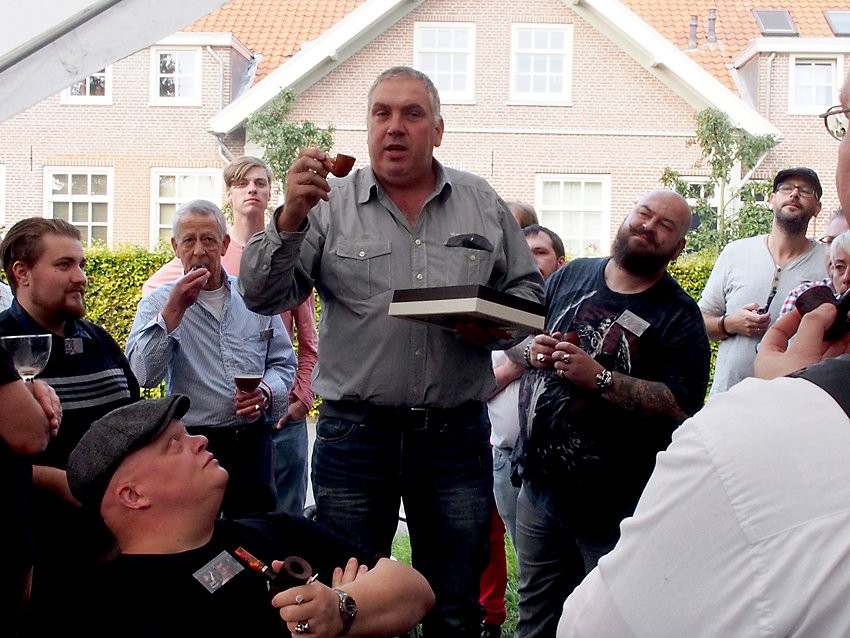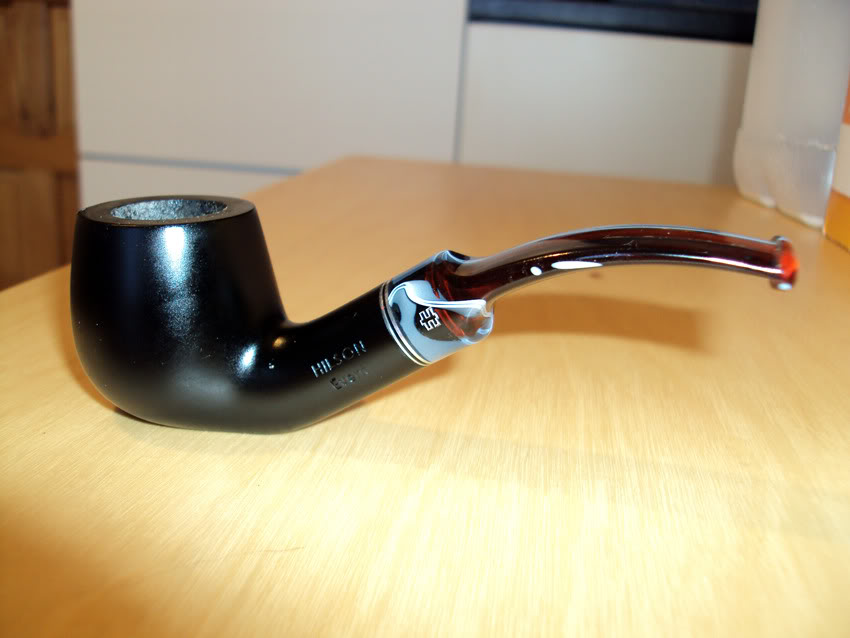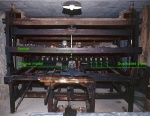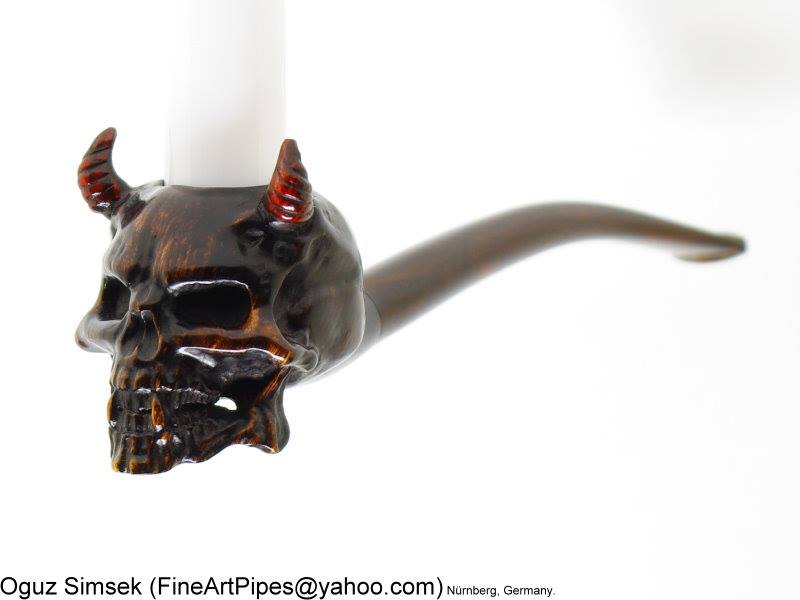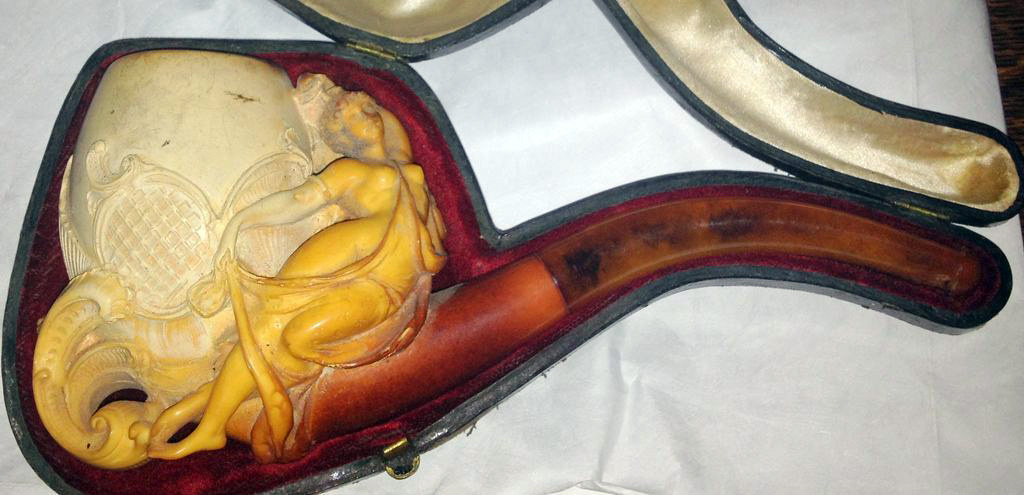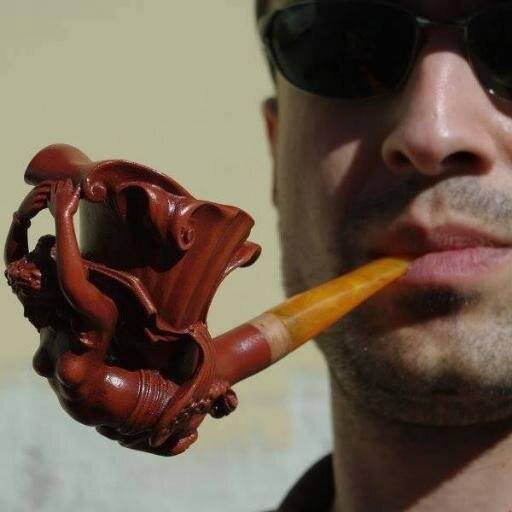In my Hospitable Heukelum 2014 blogpost I revealed that the 2015 PRF forum year-pipe was going to be made by Dutch pipe-brand Big Ben. Like I told before, normally Shaun arranges the whole project but sadly he had been very ill this year.. Despite his sickness he managed to reach out for help and Dre answered his call. Dre (Andre) has very good connections with the Gubbels family from the Big Ben and Hilson pipe factory and regularly visits the place. So he asked if they could mean anything for the PRF pipe project. Unfortunately Big Ben only fire up their machines for a minimum of 500 pipes and the forum can never reach that number. BUT they had an alternative solution.
Throughout the years Gubbels kept pipe-bowls from their Barbados range behind with an exceptional grain and we could have those! Plus they added a metal ring on top of the bowl which made the pipe look even better. Then there was another problem, one can’t buy directly from the Gubbels factory. Luckily Primera Wouters in Weert were prepared to distribute the pipes. When Shaun and Dre told this and showed the pipe they got a very well deserved applause. Just over 60 pipes were available and when forum-members could order them they all were gone in no time! To be perfectly honest, I did not apply for one. I simply did not like the shape, but came to regret it later.
When I wanted to begin with pipe-smoking I knew nothing except that a Big Ben was a good pipe to start with. However, I preferred a model that was made by Hilson, a Hilson Event. The store owner explained to me that Hilson was made in the same factory as Big Ben. “Ok, I’ll take it!”, I said and bought my first pipe. Later I bought a Big Ben which roughly had the same model as the Hilson Event because I simply liked that shape back then. Both pipes I do not have any more, I gave them away when my tastes began to develop and change.
The histories from Big Ben and Hilson have a lot of similarities and from a point in time even intertwine. It all started for the Gubbels family in 1873 with the shop of Johannes Henricus Gubbels in the Dutch city of Roermond. There he sold things like newspapers, walking sticks, umbrellas, toys and last but not least, smoking accessories. One of the suppliers of those was a German man called Jean Knödgen who had started to make clay pipes in 1846 in the Belgian city of Bree. For a long time Johannes ran his business together with his wife, Dijmphna Hubertina. After her death in 1896 he got married again to Anna Maria in 1899. She bore him two children and when Johannes died in 1911 she continued the business. In 1924 her 2 children, Antonia and Elbert Gubbels, established the “A & H Gubbels” company which specialized in the wholesale trading of smoking accessories.
 Meanwhile in Belgium the Bree pipe factory had a new owner. Jean Hillen, the son-in-law of Knödgen, had bought the company at the end of the 19th century. He had also made contact with French pipe-makers in the area of Saint-Claude who supplied him with briar wood and Jean would finish them off. Thus, alongside the traditional clay pipes, he was able to offer more modern pipes. Around 1924 Hillen was perfectly capable of creating briar pipes on his own.
Meanwhile in Belgium the Bree pipe factory had a new owner. Jean Hillen, the son-in-law of Knödgen, had bought the company at the end of the 19th century. He had also made contact with French pipe-makers in the area of Saint-Claude who supplied him with briar wood and Jean would finish them off. Thus, alongside the traditional clay pipes, he was able to offer more modern pipes. Around 1924 Hillen was perfectly capable of creating briar pipes on his own.
Up to WWII Elbert Gubbels extended his business, mainly getting his supplies from France and England. Unfortunately The Netherlands were invaded by German troops in 1940 so the family fled north where they tried to make a living by buying and selling what little there was available. In 1945 at the end of the war they returned home to continue the business. A difficult task as material was lacking and importing stuff was almost impossible. In that period Elbert Gubbels, now the sole owner of the business, decided to follow in Jean Hillen’s foot steps. He became totally independent and produced everything himself. The factory began with 2 machines and 3 French artisans in a small workshop. In Bree a factory already existed and the sons of Hillen also worked there. Jos was in charge of sales and Albert production. The brand name of the pipes that were sold abroad was simple: Hilson, to be precize, Hillen and Sons.
 Gubbels had no brand name yet, he just had the name “EGRO” which stood for “Elbert Gubbels Roermond”. The number of machines, personnel, working space and quality of product were increased which resulted in a higher output. That made it necessary to expand the market experience and the wholesale network were no longer sufficient. A brand name was needed in order to increase sales, especially abroad. At that time another Dutch company, “De Rijk & Zonen” from Amsterdam, was doing badly. It was not a large company and to be honest, not so interesting. But it did sell British-made pipes with a sought-after, glamorous brand name well-known in many countries: Big Ben. So in 1956 Gubbels bought the whole De Rijk company. As a result exports soared in Europe, the USA, Canada and many other countries.
Gubbels had no brand name yet, he just had the name “EGRO” which stood for “Elbert Gubbels Roermond”. The number of machines, personnel, working space and quality of product were increased which resulted in a higher output. That made it necessary to expand the market experience and the wholesale network were no longer sufficient. A brand name was needed in order to increase sales, especially abroad. At that time another Dutch company, “De Rijk & Zonen” from Amsterdam, was doing badly. It was not a large company and to be honest, not so interesting. But it did sell British-made pipes with a sought-after, glamorous brand name well-known in many countries: Big Ben. So in 1956 Gubbels bought the whole De Rijk company. As a result exports soared in Europe, the USA, Canada and many other countries.
Meanwhile the business Hilson was flourishing, producing a wide range of well-crafted and creative pipes. These were selling well in Europe and elsewhere thanks to their excellent reputation and good value for money. On the other hand the production of Gubbels was more traditional in style: natural or black briar models, straight or bent, just classic pipe design. Well, one exception.. In that period the Pipo pipe appeared, a very small “nose-burner” designed by Alfons Gubbels, the son of Elbert, who had by that time joined the business together with his brother Jos. Alfons was in charge of production and Jos sales. The unorthodox Pipo pipe was highly successful, selling world-wide, including the USA. At the end of 1972 the company moved into a bigger factory. Also the much coveted title “Royal”, in the name of Queen Juliana, was granted. Thus the company name became “Elbert Gubbels en Zonen – Koninklijke Fabriek van Tabakspijpen” (“Elbert Gubbels and Sons – Royal Dutch Pipe Factory”).
 At the end of the 1970’s there were only two pipe factories left in the Benelux countries, those of Gubbels and Hillen. Two different but also complementary enterprises. Gubbels sold well in America with their Big Ben pipes while Hilson was a popular pipe-brand on the German market. However, both companies produced high-quality workmanship. So in 1980 Gubbels bought Hillen, who sadly was experiencing serious financial difficulties. It was decided that all machines, material and experts were to be moved to the Gubbels factory.
At the end of the 1970’s there were only two pipe factories left in the Benelux countries, those of Gubbels and Hillen. Two different but also complementary enterprises. Gubbels sold well in America with their Big Ben pipes while Hilson was a popular pipe-brand on the German market. However, both companies produced high-quality workmanship. So in 1980 Gubbels bought Hillen, who sadly was experiencing serious financial difficulties. It was decided that all machines, material and experts were to be moved to the Gubbels factory.
At first the two brands had some difficulty in co-existing. For example, some Big Ben pipes of that period could be confused with Hilsons and vice-versa. All by all that period of adjustment was positive, characterized by a high output. However, something was changing in the world of pipes and the market crisis meant that quite a few things had to be re-considered. It was not enough to increase quality in order to compensate for the drop in quantity. Greater investments had to match high-performance products. In 1989 Alfons (Fons) junior (technical production and design) and Elbert junior (sales) took over from their father Alfons senior and uncle Jos and the family tradition was carried on.
Since then the company has striven for excellence in every aspect of their production and above all in their mission: offering an increasingly discerning clientèle unique pipes. So since 2008 Rainer Barbi, the late famous German pipe maker, has been contributing to production and had the task of remodelling the Hilson brand until his unfortunate death. Also another great pipe maker, Former, has recently decided to offer Gubbels his creative sensitivity, art and some of his time. Besides manufacturing Big Ben, Hilson and other more minor brands Gubbels has also worked in partnership with other companies to create or refine unique models, such as Porsche Design (from 2005 to 2013) and currently Bentley. Unfortunately the financial crisis hit Gubbels in 2012 and the banks no longer wanted to finance the company. Who smokes these days?? So bankruptcy was a logical consequence, an unpleasant period. But the Gubbels family pulled through with capital of their own and had a new start. There was a change of direction with 20 in stead of 28 employees and despite the difficult market the export is growing. The Gubbels company is on the rise once again.
 Back to the forum-pipe, I really wanted to see the process in the factory so with thanks to Dre and Fred I could phone Elbert jr. for an appointment. He already knew my name, I could pay a visit, see the process, take pictures, ask questions, no problem at all. I knew a bit what to expect because I had been before at the new factory with a group of the PRF-forum just before the financial crisis hit Gubbels back in 2011. So on a morning I drove to Herten (municipality of Roermond) dressed to impress because eeyz, you can’t arrive in jeans and a sweater at the only pipe-factory left in The Netherlands right? Because of the crisis the Gubbels offices had moved in the big building used by several companies so I happily announced myself at the wrong desk. Luckily the friendly secretary of the neighbouring enterprise pointed me in the correct direction. After a good ring at the doorbell of Gubbels one of the employees let me in, guided me to the visitor room and went to get Elbert jr. Before he walked in I was able to quickly snap some pictures of the displayed pipes.
Back to the forum-pipe, I really wanted to see the process in the factory so with thanks to Dre and Fred I could phone Elbert jr. for an appointment. He already knew my name, I could pay a visit, see the process, take pictures, ask questions, no problem at all. I knew a bit what to expect because I had been before at the new factory with a group of the PRF-forum just before the financial crisis hit Gubbels back in 2011. So on a morning I drove to Herten (municipality of Roermond) dressed to impress because eeyz, you can’t arrive in jeans and a sweater at the only pipe-factory left in The Netherlands right? Because of the crisis the Gubbels offices had moved in the big building used by several companies so I happily announced myself at the wrong desk. Luckily the friendly secretary of the neighbouring enterprise pointed me in the correct direction. After a good ring at the doorbell of Gubbels one of the employees let me in, guided me to the visitor room and went to get Elbert jr. Before he walked in I was able to quickly snap some pictures of the displayed pipes.
Just like on the phone Elbert jr. is a very nice man to talk to, clearly someone with a passion for his company and the products made there. We chatted away for a while until he got a call from his brother that he was ready for me. Elbert jr. guided me to the big assembly hall where all pipes are made and Fons jr. was waiting for my arrival. For the outside world Elbert jr. is the face of Gubbels but inside the factory Fons jr. reigns supreme. At this moment he is the only one there who knows and is able to perform all the necessary steps in the creation of a pipe. The other employees just know a few steps of the process. Which worries him sometimes, I mean, what if he becomes ill? But they are working on that.
Fons jr. and a colleague had prepared (as far as they could) the steps in the finishing of the forum-pipe so I could take pictures of it. Remember, all the bowls and mouthpieces were already roughly made. Below you can see all 10 steps of the process:
1. Mounting the mouthpiece.
2. Sanding the pipe from coarse to fine with different sizes of sanding discs.
3. Staining the pipe (3 layers of stain are applied in total) where the first layer of stain is set aflame to fixate it.
4. Removing excess stain.
5. Sanding off more of the stain to make the grain better visible.
6. Milling out space for the metal top-ring.
7. Spraying a lacquer finish on the pipe.
8. Buffing the pipe to make it extra shiny.
9. Putting on the metal top-ring.
10. Tadaaa!! The finished product.
After explaining all the steps of the process Fons jr. guided me further around the factory. In the back there was a smaller hall with a big basket stacked full with briar and equipment to shape the bowls including a big modernized version of the Lamberthod machine. Of course the precise operation of everything was demonstrated. Seeing the immense Lamberthod device in action was very impressive, especially because Fons jr. had left the hood open so I could make some pictures. Afterwards he had to laugh when he looked at me, because my classy black suit was totally covered in the sawdust that came out of the machine.. “You will still find it in your clothes when you go to sleep tonight” he said with a big grin.
I also was led through the immense warehouse where you can find lots of pipes, pipes and ehrr.. Pipes! Uncountable boxes, drawers and crates stacked on to each other filled with unfinished pipe bowls, stems in all shapes and colours, (metal) rings etc. An impressive sight! There was only a small pallet with ebonite mouthpieces, Gubbels does not really use them because acryl is more durable.. Last but not least we went to a part of the warehouse where a couple of friendly ladies were packing orders.
 When the tour was finished Fons jr. and I sat together so he could explain the forum-pipe process to me once more and I could write down the steps. We talked a bit more and then it was time for me to leave and for him to go back to the assembly hall. I must say, my respect for Gubbels and especially for Fons jr. had really grown. If you just look at the new Bentley pipes and know how much difficult handwork is needed for the creation of those..
When the tour was finished Fons jr. and I sat together so he could explain the forum-pipe process to me once more and I could write down the steps. We talked a bit more and then it was time for me to leave and for him to go back to the assembly hall. I must say, my respect for Gubbels and especially for Fons jr. had really grown. If you just look at the new Bentley pipes and know how much difficult handwork is needed for the creation of those..
Anyway, I wish all people who have ordered the 2015 PRF forum year-pipe lots of smoking pleasure with it! It is an extraordinary pipe with stunning grain for a very, very good price and I really regret I did not order one now.. Thanks go out to Dre, Shaun, Fred, Elbert jr., Fons jr., Fons sr. and the employees at Gubbels for making the forumpipe and this blogpost possible!
The Dutch/Belgian Pipe Smokers Forum visits Gubbels in 2011 (in Dutch):
Gubbels brandstory video:
Very old video of how pipes were made at Gubbels:
UPDATE 11-07-2019:
Sadly E. Gubbels in Herten, the Royal Factory of tobaccopipes (i.e. Big Ben), is bankrupt. The artisanal production branch of the family company is no more after 149 years. The trading house, Gubbels Trade and BV Gubbels Pipecleaners, on the other hand, continue to exist.
With the production of fully handmade briar wooden tobacco pipes finally stopped, Elbert and Alfons Gubbels say goodbye to a piece of company DNA and cultural heritage. But also from six involved employees.
“I had hoped to be able to maintain production,” says Elbert Gubbels in an explanation. “But the anti-smoking lobby and the government’s policy of discouragement are terrible. Fewer smokers, fewer stores. While pipe smoking is a certain lifestyle that requires good communication.”
Gubbels wants to keep a part of its history visible, but is removing the expensive machine for the Big Ben pipes from the company. “We have a solid stock and cannot keep on stacking. We will first sell it and then have the new pipes made in Italy. Where the briar also comes from. Then we give it a final touch in Herten. This is how we maintain our global market. On a small scale, with around ten, eleven employees, we hope to be able to continue for a very long time.

